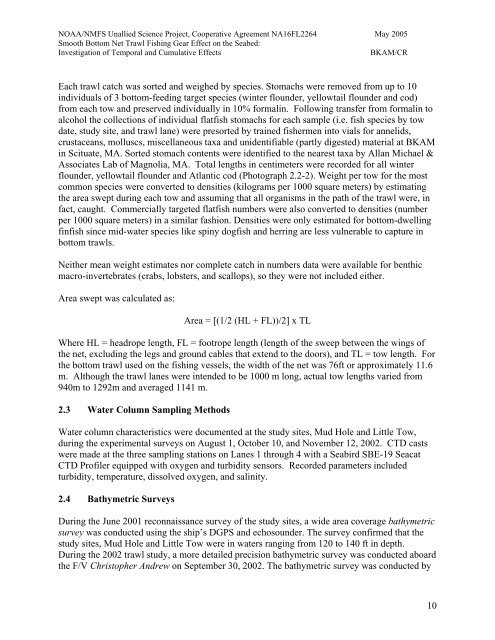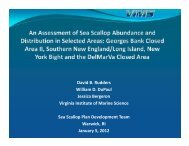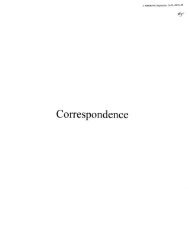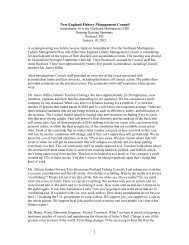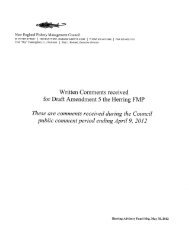Smooth Bottom Net Trawl Fishing Gear Effect on - New England ...
Smooth Bottom Net Trawl Fishing Gear Effect on - New England ...
Smooth Bottom Net Trawl Fishing Gear Effect on - New England ...
You also want an ePaper? Increase the reach of your titles
YUMPU automatically turns print PDFs into web optimized ePapers that Google loves.
NOAA/NMFS Unallied Science Project, Cooperative Agreement NA16FL2264 May 2005<br />
<str<strong>on</strong>g>Smooth</str<strong>on</strong>g> <str<strong>on</strong>g>Bottom</str<strong>on</strong>g> <str<strong>on</strong>g>Net</str<strong>on</strong>g> <str<strong>on</strong>g>Trawl</str<strong>on</strong>g> <str<strong>on</strong>g>Fishing</str<strong>on</strong>g> <str<strong>on</strong>g>Gear</str<strong>on</strong>g> <str<strong>on</strong>g>Effect</str<strong>on</strong>g> <strong>on</strong> the Seabed:<br />
Investigati<strong>on</strong> of Temporal and Cumulative <str<strong>on</strong>g>Effect</str<strong>on</strong>g>s BKAM/CR<br />
Each trawl catch was sorted and weighed by species. Stomachs were removed from up to 10<br />
individuals of 3 bottom-feeding target species (winter flounder, yellowtail flounder and cod)<br />
from each tow and preserved individually in 10% formalin. Following transfer from formalin to<br />
alcohol the collecti<strong>on</strong>s of individual flatfish stomachs for each sample (i.e. fish species by tow<br />
date, study site, and trawl lane) were presorted by trained fishermen into vials for annelids,<br />
crustaceans, molluscs, miscellaneous taxa and unidentifiable (partly digested) material at BKAM<br />
in Scituate, MA. Sorted stomach c<strong>on</strong>tents were identified to the nearest taxa by Allan Michael &<br />
Associates Lab of Magnolia, MA. Total lengths in centimeters were recorded for all winter<br />
flounder, yellowtail flounder and Atlantic cod (Photograph 2.2-2). Weight per tow for the most<br />
comm<strong>on</strong> species were c<strong>on</strong>verted to densities (kilograms per 1000 square meters) by estimating<br />
the area swept during each tow and assuming that all organisms in the path of the trawl were, in<br />
fact, caught. Commercially targeted flatfish numbers were also c<strong>on</strong>verted to densities (number<br />
per 1000 square meters) in a similar fashi<strong>on</strong>. Densities were <strong>on</strong>ly estimated for bottom-dwelling<br />
finfish since mid-water species like spiny dogfish and herring are less vulnerable to capture in<br />
bottom trawls.<br />
Neither mean weight estimates nor complete catch in numbers data were available for benthic<br />
macro-invertebrates (crabs, lobsters, and scallops), so they were not included either.<br />
Area swept was calculated as:<br />
Area = [(1/2 (HL + FL))/2] x TL<br />
Where HL = headrope length, FL = footrope length (length of the sweep between the wings of<br />
the net, excluding the legs and ground cables that extend to the doors), and TL = tow length. For<br />
the bottom trawl used <strong>on</strong> the fishing vessels, the width of the net was 76ft or approximately 11.6<br />
m. Although the trawl lanes were intended to be 1000 m l<strong>on</strong>g, actual tow lengths varied from<br />
940m to 1292m and averaged 1141 m.<br />
2.3 Water Column Sampling Methods<br />
Water column characteristics were documented at the study sites, Mud Hole and Little Tow,<br />
during the experimental surveys <strong>on</strong> August 1, October 10, and November 12, 2002. CTD casts<br />
were made at the three sampling stati<strong>on</strong>s <strong>on</strong> Lanes 1 through 4 with a Seabird SBE-19 Seacat<br />
CTD Profiler equipped with oxygen and turbidity sensors. Recorded parameters included<br />
turbidity, temperature, dissolved oxygen, and salinity.<br />
2.4 Bathymetric Surveys<br />
During the June 2001 rec<strong>on</strong>naissance survey of the study sites, a wide area coverage bathymetric<br />
survey was c<strong>on</strong>ducted using the ship’s DGPS and echosounder. The survey c<strong>on</strong>firmed that the<br />
study sites, Mud Hole and Little Tow were in waters ranging from 120 to 140 ft in depth.<br />
During the 2002 trawl study, a more detailed precisi<strong>on</strong> bathymetric survey was c<strong>on</strong>ducted aboard<br />
the F/V Christopher Andrew <strong>on</strong> September 30, 2002. The bathymetric survey was c<strong>on</strong>ducted by<br />
10


